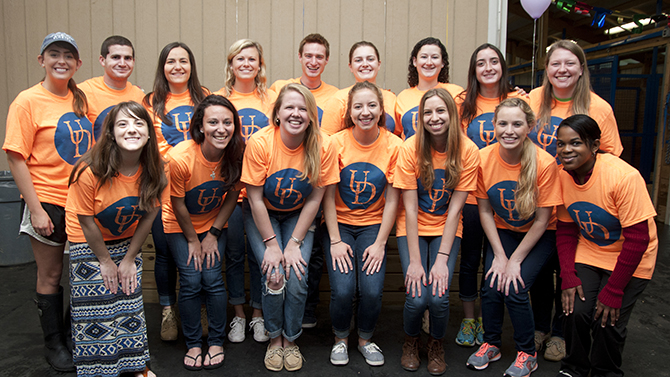


VETERINARY SCHOOL PLACEMENT
Photo by Wenbo Fan June 15, 2016
CANR pre-veterinary program sends 29 students to vet, medical schools
The University of Delaware College of Agriculture and Natural Resources’ pre-veterinary medicine and animal biosciences program had its most successful spring on record, sending 29 students to veterinary and medical schools with an acceptance rate of 96 percent.
The program has a long history of success, with an average acceptance rate of around 80 percent – significantly higher than the national average of veterinary school acceptance rate, which is around 50 percent according to the Association of American Veterinary Medical Colleges.
Eight of those students were accepted to Ivy League schools with five going to the University of Pennsylvania and three to Cornell University. Three students were accepted to Tufts University and two students were accepted into medical school. One student in particular was accepted into 12 veterinary schools.
Lesa Griffiths, the T.A. Baker Professor in CANR, said that the success of the students is contingent on many factors, with one of the most important being the location of a working farm right on campus. That provides students critical hands-on discovery learning opportunities.
“What is unique about us, and getting more and more unique, is the 350-acre farm right on campus. Students have access to the farm 24/7 and they don’t have to take buses or rely on transportation to the farm, so we’re able to incorporate the farm into many of our classes and undergraduate research and our internship experiences. I think that still having a farm and then having it right on campus is getting more and more unique,” said Griffiths.
The farm is utilized from day one for students in the program. Beginning with their first fall semester, students get to go out on the farm and participate in discovery learning.
The discovery learning also comes in the form of undergraduate research opportunities offered by the Department of Animal and Food Sciences (ANFS) and field experience courses in which students work on the UD farm, other local farms, or with local veterinarians and animal shelters.
The program also offers a curriculum that reflects a unique combination of faculty expertise, with strengths in animal health and nutrition and the interactions between animal health and animal nutrition.
“It is unusual to have a faculty very focused on animal health and nutrition and that grew out of the link to the poultry industry and poultry health, although it’s much more basic now in terms of microbiology and virology. The microbiology has grown out of links to both food science and food safety, and now with the huge interest in the gut microbiome and its link to human health,” said Griffiths.
Griffiths also pointed to the program’s faculty expertise and advising capabilities as setting the students up for success.
“We have a lot of advisees so I think the fact that we can continue to make it very personal and one on one is really critical,” said Griffiths. “We work very hard to try to maintain one on one interaction and we’re very good at backing each other up. If a student can’t reach his or her adviser and contacts me, I will fill in. The faculty members talk about advising and share information about veterinary schools and advising. I think we encourage student-faculty interaction and do our best to make connections with students.”
The closeness that alumni of the program feel toward it can be seen in the fact that every year, UD graduates who are now enrolled in the University of Pennsylvania School of Veterinary Medicine come back and participate in a panel talk for the animal science club with advice for applying to veterinary school and discussions about their experiences in veterinary school.
Veterinary school applications
To help current students with the process for applying to veterinary school, the department worked with Christy Mannering, communications specialist in CANR, to set up a website that takes students through the four-year process of applying to veterinary school.
The website includes frequently asked questions about veterinary school and reminders by year, as well as interview questions and comments on interviews from alumni who have just gone through the interview process.
The animal and food sciences faculty advisers help the students with the intensive and detailed application process for veterinary school by providing recommendation letters, reviewing their personal statements and sharing their knowledge about the application process. As part of the process, students have to document not only their academic program and their academic success but the number of hours they’ve worked while shadowing veterinarians and hours worked interacting with animals.
The application also includes a personal statement and many veterinary schools have follow up personal statements so the whole process involves a lot of writing, which Griffiths said means the students have to make themselves stand out and distinguish themselves from other students.
Griffiths singled out one statement in particular from a student who happened to be a cheerleader at UD. Both Griffiths and Erin Brannick, director of the CANR Comparative Pathology Laboratory and assistant professor in ANFS, told him independently that he should include that piece of information in his essay.
“We both told him to go back and we said, we don’t really care if the admissions committee doesn’t remember your name, but you want them to say, ‘Hey, where’s that cheerleader guy? We want him.’ After revisions, his statement came back equating how being a cheerleader helped him in all the skills he’s developed, such as self-confidence, time management and all those important life skills and professional development skills.”
Contact Us
Have a UDaily story idea?
Contact us at ocm@udel.edu
Members of the press
Contact us at 302-831-NEWS or visit the Media Relations website

